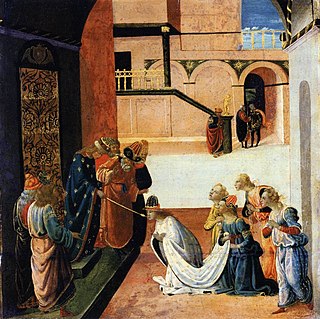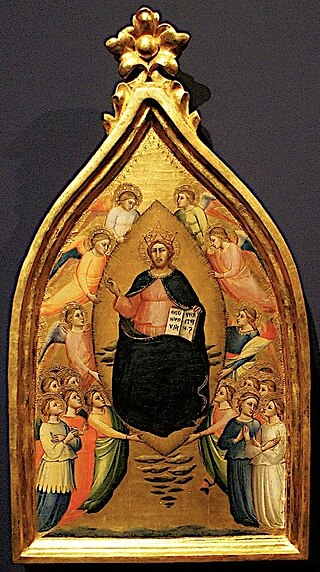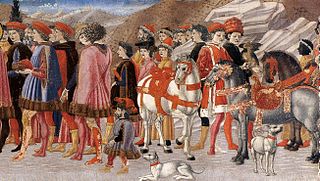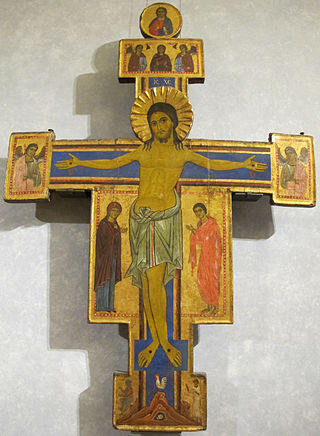
Meliore di Jacopo (fl. 1255-1285) was a Medieval Italian painter from Florence.

Meliore di Jacopo (fl. 1255-1285) was a Medieval Italian painter from Florence.
The first certain reference to him is from 1260, when he appears as "Megliore dipintore" in a list of Florentine citizens who participated in the Battle of Montaperti. [1]
His youthful works date from c.125o to 1260. They include a "Madonna and Child" from a church in Panzano (Greve in Chianti), the "Stoclet Madonna" in the Adolphe Stoclet collection and the "Madonna and Child" at the Art Institute of Chicago. Most of his works are influenced by the geometric stylization of the Master of the Bigallo Crucifix.
His later works are grouped around a key work that was signed and dated in 1271; an altarpiece, preserved in the Uffizi, which depicts Christ, the Virgin, Saint Peter, Saint Paul and Saint John the Evangelist. It represents a stylistic departure that is reminiscent of Cimabue.
Dated sometime between 1270 and 1275 is a "Madonna and Child with Two Angels"; originally at the church of Santa Maria, previously located in Bagnaldo, a district in Certaldo and now preserved at the nearby Museum of Religious Art. [2]
His "Madonna and Child" in Montefioralle (Greve in Chianti) is one of his last works, after 1280, and shows the influence of novelties introduced by Giotto. [2]
There is another "Madonna and Child" at the Museum of Religious Art in Tavarnelle Val di Pesa that has tentatively been attributed to him. It was apparently painted in imitation of Coppo di Marcovaldo, a companion of his from the Battle of Montaperti. Part of the mosaic decorations in the dome at the Church of Santa Maria Maggiore, created between 1260 and 1275, may also be his.
Many of his works were once attributed to an artist with the notname, "Master of Bagnano". Some were reassigned to Meliore by Roberto Longhi and the remainder are now assumed to have been the work of one or more of his apprentices. [3]

Greve in Chianti is a town and comune (municipality) in the Metropolitan City of Florence, Tuscany, Italy. It is located about 31 kilometres (19 mi) south of Florence and 42 kilometres (26 mi) north of Siena.

Castelfiorentino is a city and comune (municipality) in the Metropolitan City of Florence, Tuscany, central-northern Italy, located between Florence, Pisa (45 km) and Siena (55 km). The population numbers approximately 20,000 inhabitants. It is part of Valdelsa. Castelfiorentino borders the following municipalities: Certaldo, Empoli, Gambassi Terme, Montaione, Montespertoli and San Miniato.

Coppo di Marcovaldo was a Florentine painter in the Italo-Byzantine style, active in the middle of the thirteenth century, whose fusion of both the Italian and Byzantine styles had great influence on generations of Italian artists.

Jacopo del Sellaio (1441/42–1493) was an Italian painter of the early Renaissance, active in his native Florence. His real name was Jacopo di Arcangelo. He worked in an eclectic style based on those of Botticelli, Filippino Lippi, and Domenico Ghirlandaio. The nickname Sellaio derives from the profession of his father, a saddle maker.

Lorenzo di Bicci was an Italian painter of the Florentine School considered to be one of the most important painters in Florence during the second half of the 14th century. He is believed to have learned his trade from his father, about whom little is known. Lorenzo’s style, as well as that of his contemporaries Jacopo di Cione and Niccolò di Pietro Gerini, was influenced by the artist Andrea di Cione. Lorenzo's paintings made use of bright colors and his compositions avoided complexity. The figures he painted tended to have round faces and were often expressionless. Another one of Lorenzo's distinctive characteristics was his precision of execution. He was known for exceptional talent in drawing, an ability that he put to use at the initial stages of his painting. Unlike many celebrated Florentine artists of this period, Lorenzo mostly received commissions from the country clergy and from the lower-middle-class Florentine guilds. His successors, Bicci di Lorenzo and Neri di Bicci, continued to serve these groups.

Biagio d’Antonio Tucci was an Italian Renaissance painter active in Florence, Faenza and Rome.

Bastiano di Bartolo Mainardi (1466–1513) was an Italian painter of the Early Renaissance. He was born in San Gimignano and was active there and in Florence.

Pier Francesco Fiorentino was a 15th-century painter active in San Gimignano for much of his mature life, depicting religious-themed subjects.

The Madonna del Bordone is a panel painting by the Italian painter Coppo di Marcovaldo, in the church of Santa Maria dei Servi in Siena, Italy.

The Pucci family has been a prominent noble family in Florence over the course of many centuries. A recent notable member of this family was Emilio Pucci, an Italian fashion designer who founded a clothing company after World War II.

Mariotto di Nardo di Cione was a Florentine painter in the Florentine Gothic style. He worked at the Duomo of Florence, the church of Santa Maria Maggiore, and the Orsanmichele. He created both frescoes and panel paintings, and was also active as a manuscript illuminator.

Niccolò da Uzzano was an Italian politician, banker and Renaissance humanist, the Gonfaloniere of Justice in the government of Florence, where he was an associate of the Medici family.

The Master of Pratovecchio was an Italian painter of the Renaissance, named by Roberto Longhi in a 1952 article on the basis of stylistic similarities of a number of works to an altarpiece painted for the monastery of San Giovanni Evangelista in Pratovecchio. The centre panel of the triptych, depicting the Assumption of the Virgin is currently on deposit in Arrezo; the left and right side-panels are in the National Gallery, London.

Giovanni di Francesco del Cervelliera or Giovanni di Francesco was an Italian Renaissance painter, active in Florence in the mid-fifteenth century.

Cenni di Francesco di ser Cenni was an Italian Gothic painter active in Florence between 1369/1370 and 1415. His only signed work is the fresco of the True Cross at the Cappella della Croce di Giorno at the church of San Francesco in Volterra, painted in 1410. A couple of dozen works have been attributed to Cenni di Francesco on the basis of a similarity of style with the fresco.

Saint Dominic in Soriano was a portrait of Saint Dominic (1170–1221) painted in 1530. It is an important artefact in the Dominican friary at Soriano Calabro in southern Italy. It was believed to be of miraculous origin, and to inspire miracles. It was the subject of a Roman Catholic feast day celebrated on 15 September from 1644 to 1913. Its miraculous origin was the subject of several 17th-century paintings. Several ecclesiastical buildings have been named after it.
Antonia di Paolo di Dono (1456–1491) was the daughter of Paolo di Dono, nicknamed Uccello, a well-known early Renaissance Florentine painter. Giorgio Vasari's biography of Uccello states that he had "a daughter who knew how to draw." Antonia was recorded in the Libro dei Morti of the painter's guild, Arte dei Medici e Speziali, as a "pittoressa." This was the first time the feminine form of the word "painter" appears in Florentine public records and the first formal recognition of a fifteenth-century woman artist.

The Master of the Bigallo Crucifix or Bigallo Master was an Italian painter active around Florence in the first half of the 13th century. He ran one of the first fully organized workshops before Cimabue, specializing in large painted crucifixes for churches, one of the main formats for panel paintings at the time. His notname comes from one of these in the Museo del Bigallo in Florence. A similar work is in the Palazzo Barberini site of the Galleria Nazionale d'Arte Antica museum, Rome.

Christ the Redeemer with Four Saints is a 1271 tempera and gold on panel painting, signed and dated by Meliore di Jacopo. From the left to right the saints are Peter, the Virgin Mary, John the Evangelist and Paul of Tarsus. It is now in the Uffizi Gallery in Florence.
The Museum of Religious Art' is an art gallery and museum in Certaldo, opened in 2001 and one of the town's three museums.
![]() Media related to Meliore di Jacopo at Wikimedia Commons
Media related to Meliore di Jacopo at Wikimedia Commons